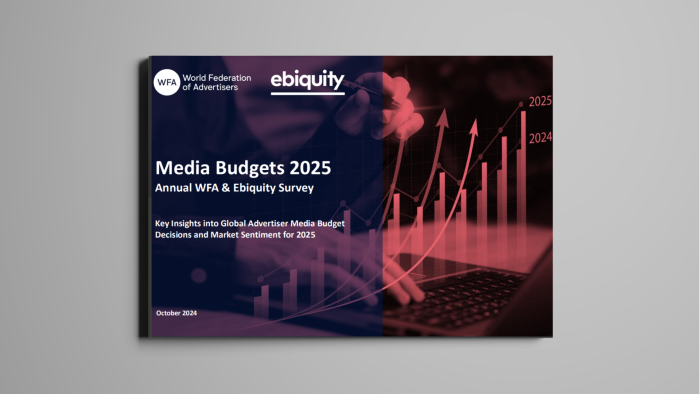Get analysis, insight & opinions from the world's top marketers.
Sign up to our newsletter.
The latest WFA and Ebiquity study indicates a further rise in media budgets next year, but positive movement is likely to be more targeted than in previous years says Tom Ashby, Global Lead Media Services at WFA.

Uncertainty has been the watchword for 2024 and that’s likely to continue next year. So it’s a measure of advertising’s resilience and importance that most media experts are expecting continued growth overall.
One reason for that is the rise of retail media, which is creating opportunity but also, potentially, some risk for the long-term health of brand building as we further embrace performance marketing.
It’s too early to judge the potential transformative impact of AI but what we can do is ensure we all implement the measurement frameworks we need for today, not least to ensure we can measure across an increasingly fragmented ecosystem.
Looking at the numbers from our survey of the buy-side, 49% of respondents anticipate budget increases, compared to 17% forecasting reductions.
While this suggests a positive trajectory, the pace of growth appears to be slowing. Our Q3 2023 predictions for 2024 indicated a more bullish outlook, with 60% expecting increases versus only 7% projecting declines.
Aside from lower levels of optimism, this year’s numbers also indicated a number of key trends, including:
Regional disparities are striking, with North American media teams notably less optimistic than their counterparts in Europe and APAC. Only 30% of North American respondents expect budgets to rise, compared to 50% in Europe and 37% in APAC. While the exact reasons remain unclear, several theories have emerged. Regional budgets may have hit a natural plateau following rapid expansion in 2024, taking a pause as other regions catch up. Alternatively, uncertainty around the U.S. elections, which occurred after the survey period, could have delayed budget confirmations. Regardless of the cause, this marks a significant divergence in regional sentiment.
Unsurprisingly, the data reveals continued shifts away from traditional media channels toward performance-focused channels closer to the point of purchase. Among traditional media, only out-of-home (OOH) demonstrates growth, driven exclusively by digital OOH. Winning channels include addressable/connected TV, retail media and influencer marketing. However, there are signs of stagnation in mobile/in-app spending, potentially linked to increasing privacy regulations and consumer concerns. At the same time, gaming and esports, while not experiencing significant budget cuts, continue to fall short of the much-forecasted industry-wide adoption.
It’s now more than a decade since the release of The Long and the Short of It but the tension between performance-driven media and brand-building persists. The survey highlights an accelerating bias toward performance media, with 42% of responders anticipating an increase in budget mix towards performance media (vs. 34% anticipating an increase in budget mix towards branding). Retail media's prominence is cited as a key driver, though respondents caution against equating measurement with effectiveness. As one participant noted: “The need to measure is causing budgets to shift to performance even though the measures do not always equate to effectiveness.”
For the first time, this survey explored perceptions of transparency in the media industry. Respondents were evenly divided between those who strongly agree that transparency is improving and those who believe it is deteriorating. This polarization underscores the need for continued dialogue and action to rebuild trust and foster industry-wide standards.
Sustainability offers a brighter outlook, with a slight majority predicting it will gain importance in 2025. Meanwhile, assessments of media agency talent are broadly positive, with most advertisers expressing confidence in their ability to access skilled professionals. Negative voices exist in both areas but they appear to be outliers, dragging down averages rather than defining the overall sentiment. Notably, some respondents rated sustainability and talent metrics as high as 90%+, highlighting pockets of best practice that the industry can expand upon.
Overall, the survey paints a nuanced picture for 2025: cautious optimism tempered by slowing growth, regional disparities, and enduring challenges in transparency and effectiveness.
Nevertheless, positive trends in sustainability and talent underscore marketing’s capacity for resilience and innovation, offering a foundation for future progress.
For more information or questions, please contact us

